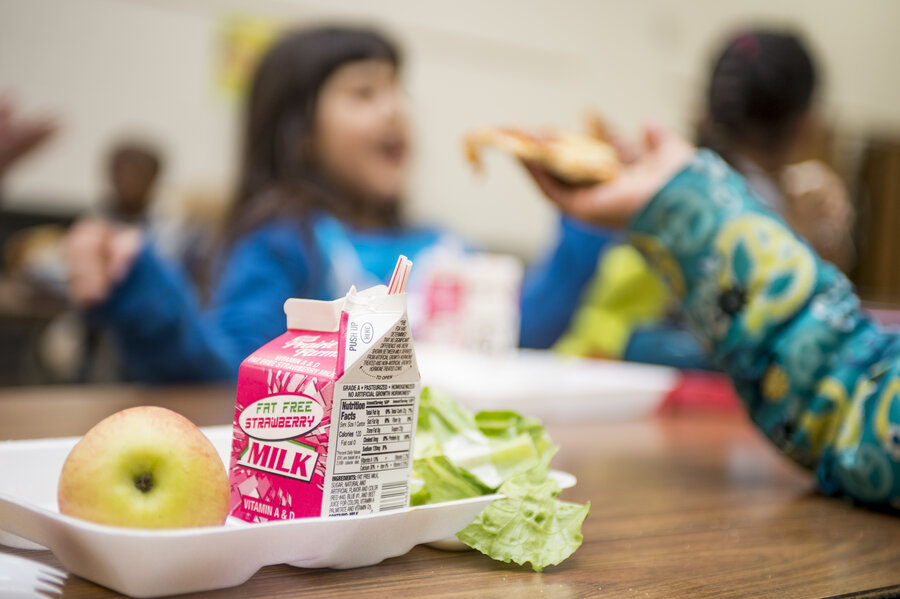For better school lunches, make them part of the lesson plan
Loading...
When new USDA lunch standards were introduced a few years ago to the 30 million children who eat at school each day, the big concern was whether they would give up potato chips for carrot sticks. Among other things, the new standards limited the number of calories per meal, required that they contain at least one serving of fruits and vegetables and pushed providers to offer more whole grains and serve fat-free or low-fat milk varieties.
In a study done by the School of Public Health at the University of Washington, researchers concluded that not only were the meals more nutritious, but the participation rates remained virtually the same even among the older students.
So where do we go from here? There is room for improvement on the quality standards set for ingredients, still the new requirements are a positive start. How do we build upon this and encourage our nation’s children to make better food choices?
The answer may lie in what I like to call the three Es of eating. The food we offer should be educational, experimental, and yes, emotional. (Of course, high quality ingredients are a given.)
Of the three, emotional may be the most controversial of all. But aren't we all guilty of emotional eating? Who hasn’t eaten dinner and then suddenly found room for dessert? What if we were to redefine emotional eating? What if we were to take this natural inclination and use it to energize healthier eating habits?
It could work something like this.
Educators could plan an interdisciplinary unit that includes the school cafeteria. During a Japan unit taught at a Connecticut elementary school, a friend’s third grader learned about volcanoes in science, haikus in language arts and traditional harmonies in music. What if that unit extended into the school's lunchroom and the children were served edamame or chicken teriyaki? Would the kids be more excited to try these new flavors when they are learning about the Japanese culture?
I've seen this practice in action on the regional level in Italy at the Reggio Emilia schools. The schools work with food providers to ensure that the cafeteria's food offerings reflect the lessons being taught. When the children learn about Roman history, they eat the dishes of the Ancient Romans, when the children learn about geography they eat the dishes of that region.
Offering foods that relate to the academic curriculum is just part of the equation. Cultural relevance is also critical in prompting children to eat healthier foods. I am the CEO of SoloFresco, a school lunch meal provider with its roots in Italy, where our goal is to serve authentic meals in the Mediterranean-style. We have served over 40 million meals to New York City’s public school children. Still, when we introduced a whole grain penne with fresh basil pesto to our NYC elementary school diners, participation rates fell. Could it have been the children's aversion to the color green or their lack of familiarity with basil?
We went back to the kitchen and came back with dishes they are more familiar with, like grilled, hickory smoke-flavored turkey burgers; whole wheat, antibiotic-free Asian-style chicken dumplings; adobo-seasoned empanadas; and Italian frittatas. Because of the overwhelmingly positive response, we are now introducing a new line of meal offerings called UnitedFlavors, in which all of the dishes reflect the cultural flavors of many of our nation’s school children. Our expanded offerings stand out in the school lunch program market because of our commitment to using a few fresh, mostly non-GMO and antibiotic-free ingredients combined together, instead of processed foods with artificial preservatives and artificial flavors.
Providing an integrated approach to food that is relevant to children's lives works. The California-based Center for Ecoliteracy supports an interdisciplinary approach to learning about food. In a three-year assessment of the School Lunch Initiative (a project of the Center for Ecoliteracy, the Chez Panisse Foundation, and the Berkeley Unified School District) researchers concluded that serving freshly cooked meals and "integrating learning about food and the environment into the academic curriculum is effective in increasing food knowledge and consumption of healthy foods, particularly fruits and vegetables among elementary school students."
Solofresco doesn't have corresponding lesson plans yet, but we're excited about what others in the food industry are developing. For example, the Dairy Council of California offers teachers a K-12 nutrition curriculum plan that can easily integrate into their units on Math, Social Science, Health, Language Arts and Physical Education. Giving school districts and meal providers greater flexibility to introduce dishes that correspond with their lesson plans could be a great next step.
For instance, children in the United States can learn about colonial history and then go to the cafeteria and eat sustainable fish, organic corn and apples that were dietary staples of the colonists. My creative juices are already flowing!
Fausto Armonti is the CEO of SoloFresco, a school lunch provider serving New York City, and coming soon to school cafeterias in Miami-Dade and Dallas.







